Where Are All The ‘Top’ Dwellers?
Beware: incessant speculation of stock market bottoms have helped brainwash investors into believing that stock market fundamentals are a different animal than corporate fundamentals.
By Brady Willett & Phil Vala
In mid July investor’s were doused by speculations that the markets were near a ‘bottom’. Seemingly unable to comment on anything else, Wall Street was quick to brandish the phrase ‘the markets have bottomed’ following the rally in late July.
As we all know the July bottom didn’t last very long. Rather, by mid-August stock prices had already ‘topped’ and a vicious sell off was underway. Furthermore, as the July’s lows were breached no bounce occurred – prices continued to tumble. Yet the chant began again: ‘stocks near a bottom, stocks near a bottom, stocks near a bottom…”
The resolve of market bottom dwellers finally paid off on October 10, or when the Dow reached a low of 7,197. As prices rallied the long term bear market bottom everyone had hoped would arrive did, or so the story goes.
The Paradox: Predicting Bottoms
One of the problems with predicting stock market bottoms is that the investor can lose site of underlying corporate fundamentals. To be sure, the reason why the current bear market challenges to be the longest bear market ever is because widespread stock market gloom has not yet transpired. Rather, just when things begin looking bleak investor’s have acquired a penchant for bottom fishing. As for those who claim the current bear market has been extremely bad, the evidence suggests otherwise – the majority of American’s are still holding stocks.
Quite frankly, the bottoms that have marked the end of previous bear markets have occurred when people were uninterested in stocks, and when no one was predicting a bottom (no one, at least not in the mainstream, cared about stocks). By contrast, during the latter part of October you couldn’t read an investment article without the word ‘bottom’ being mentioned. Suffice it to say, if 1 investor or fund manager purchased stocks in October solely because the markets formed a ‘bottom’ this is more than the total amount of investors and managers who specifically purchased stocks in the fall of 1982 because of the market bottom.
Top Dwelling Rare
What is not as popular these days is speculations about stock market ‘tops’. Granted, many have noted that the current rally may not have legs, or that prices are nearing over-bought conditions. However, few analysts and investors have explicitly focused on calling market tops, or claiming that ‘a top could be near and now is a good time to sell’, ‘when the markets top all hell is going to break lose’, and ‘now is a bad time to buy because the top cannot be far off’ (the opposite of bottom calling logic). It is now time to rectify this shortcoming.
Titillating Tops
With both the Dow and S&P 500 roughly 6% below their former tops the near term outlook is mixed: dependent upon your market outlook these totals either mean the averages are 6% away from reaching key resistance levels or 6% away from growing a set of stronger legs. Incidentally, not many people have faith in the latter.
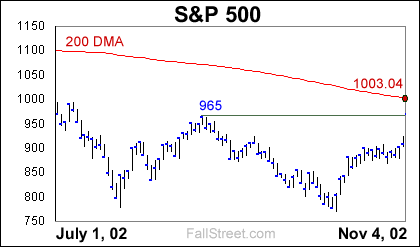 |
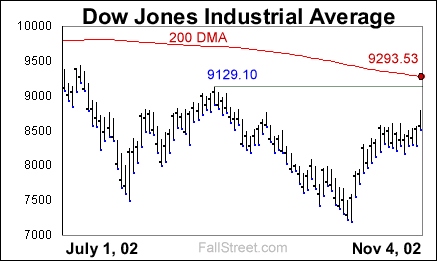 |
By contrast, the Nasdaq story is much different. Following Microsoft’s positive court developments excited investor’s rolled into tech stocks on Monday, helping send the Nasdaq index to within 6 points of its former top (1420). However, and as the action in the markets quickly showed, investors were not willing to gamble that the Nasdaq could make a new top. Thus, that the Nasdaq rallied strongly and failed to recapture its former top is a bearish development. Today’s action, with both the Dow and S&P up and the Nasdaq is flat, has confirmed the outlook for tech (the index is too close to key resistance levels to rally).
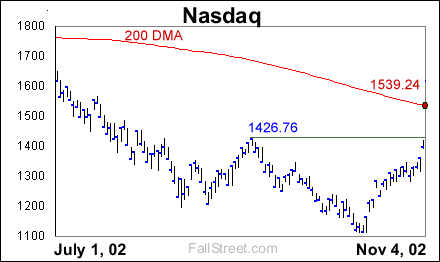 |
Another top consideration can be seen in banking stocks. Previously unnerved by default fears investors sold off bank shares. However, the rally in bank stocks (after the bottom of course) has been strong heading into tomorrow’s FOMC meeting. In fact, the rally has been so strong that the bank index is not only near its former ‘top’, but also closing in on its 200-day moving average. Those investors looking for clues of the markets direction following the FOMC announcement need only consider this collection of stocks – if bank shares decline this could, not unlike yesterday’s Nasdaq top effect on tech shares, have broader repercussion on the markets. Quite frankly, not many professionals want to buy stocks near important resistance levels if the shares do not bust through these levels with authority. Bank shares are no exception.
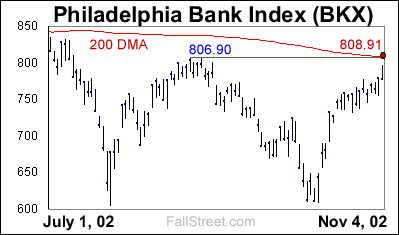 |
A final consideration is Treasury yields. In September/October the bull camp was arguing that since bond yields were unattractive stocks would surely benefit. And while this theory eventually proved correct, it did not come to pass until it was rumored that Warren Buffett was dumping zero-coupon bonds to buy corporate bonds. Point being, the bottom in Treasury yields (not unlike the bottom which occurred at the exact same time in stocks), transpired because of a rumored event (Buffett’s actions), not because of any underlying market fundamentals. As bond yields were thought to have hit bottomed money flowed out of bonds and into stocks.
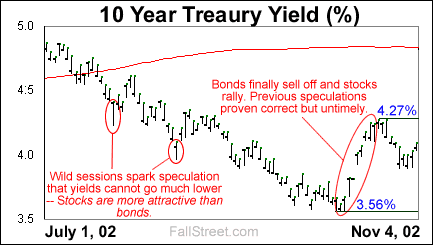 |
In sum, astute speculators will be watching bond yields and bank stocks tomorrow for clues of the markets near term direction, and the Nasdaq has already hinted that the rally is over – that the top in tech is in…
Conclusions
It is foolish to base your investment choices solely upon speculations of market tops and bottoms. However, turning points in the broader equity markets can regularly raise or lower the risk premiums associated with stocks in general. As such, you are likely to find better buying opportunities when the markets are testing their former lows than when the markets are testing their former highs.
Beyond this obvious observations the investor would also be well served to understand the generalities of bear and bull markets: bear markets make new bottoms and old tops while bull markets make new tops and old lows. For this reason, speculation on market tops during today’s bear market should warrant more speculation than bottoms. To understand how this theory works ask yourself a question: would you rather buy the Dow at 7,197 or short the Dow 9,129? Quite frankly, Dow 7,197 represents a former low – there is no inherent undervaluation at this level unless you believe low interest rates are the gospel – and Dow 9,129 represents severe overvaluation by any and all standards (including forward operational earnings compared to treasury yields). As such, based upon risk/reward scenarios it is the ‘top’ investors should be most interested in – it is the top that should be sold not the bottom that should be bought.
The Fed will likely cut interest rates at tomorrows FOMC meeting. The response following the FOMC Statement may prove important as both the Dow and S&P 500 have further room to run until they reach their former ‘tops’. If bank shares do not applaud the Fed’s actions the markets may, once again, be staring at an ominous bear market ‘top’. Suffice it to say, it could soon be time to wake up the bottom dwellers.
|
|
All data and information within these pages is thought to be taken from reliable sources but there is no guarantee as such. All opinions expressed on this site are opinions and should not be regarded as investment advice.
Copyright © 2000, 2001, 2002
FallStreet.com